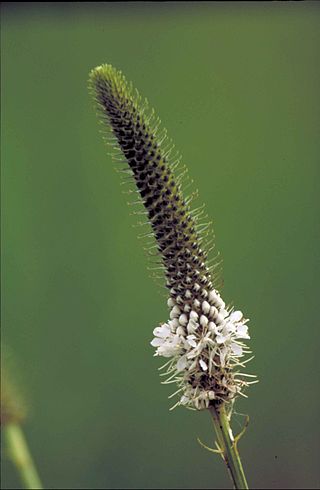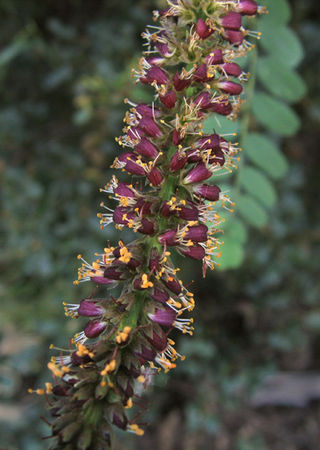
Lathyrus is a genus of flowering plants in the legume family Fabaceae, and contains approximately 160 species. Commonly known as peavines or vetchlings, they are native to temperate areas, with a breakdown of 52 species in Europe, 30 species in North America, 78 in Asia, 24 in tropical East Africa, and 24 in temperate South America. There are annual and perennial species which may be climbing or bushy. This genus has numerous sections, including Orobus, which was once a separate genus. The genus has numerous synonyms, including Pisum, the ancient Latin name for the pea.

Cercocarpus, commonly known as mountain mahogany, is a small genus of at least nine species of nitrogen-fixing flowering plants in the rose family, Rosaceae. They are native to the western United States and northern Mexico, where they grow in chaparral and semidesert habitats and climates, often at high altitudes. Several are found in the California chaparral and woodlands ecoregion.

Indigofera is a large genus of over 750 species of flowering plants belonging to the pea family Fabaceae. They are widely distributed throughout the tropical and subtropical regions of the world.

Baptisia, commonly referred to as wild indigo or false indigo, represents a diverse genus within the legume family, Fabaceae. These flowering herbaceous perennials exhibit an array of characteristics, including pea-like flowers, blooming in the spring that eventually mature into pods, occasionally displaying an inflated form. Renowned for their enduring presence and a spectrum of colours ranging from yellow, blue and white, Baptisia's captivate gardeners with their colourful stems, unique foliage, and exquisite flowers.

Dalea is a genus of flowering plants in the legume family, Fabaceae. Members of the genus are commonly known as prairie clover or indigo bush. Its name honors English apothecary Samuel Dale (1659–1739). They are native to the Western hemisphere, where they are distributed from Canada to Argentina. Nearly half of the known species are endemic to Mexico. Two species of Dalea have been considered for rangeland restoration.

Amorpha californica is a species of flowering plant in the legume family known by the common name California false indigo.

Marina is a genus in the legume family, Fabaceae. It includes 40 species native to southern North America, ranging from California and New Mexico through Mexico and Central America to Costa Rica. They are known as the false prairie clovers. Unlike the related prairie clovers, which bear two ovules per fruit, false prairie clovers bear only one ovule per fruit.

Psorothamnus is a genus of plants in the legume family. These are shrubs and small trees. Many are known by the general common name indigo bush. Some are referred to as daleas, as this genus was once included in genus Dalea. These are generally thorny, thickly branched, strongly scented bushes. Most species bear lupinlike raceme inflorescences of bright purple legume flowers and gland-rich pods. Psorothamnus species are native to the southwestern United States and northern Mexico. The genus is paraphyletic and it has been proposed that the genus Psorodendron be reinstated to accommodate sections Xylodalea, Capnodendron, and Winnemucca.

Amorpha fruticosa is a species of flowering plant in the legume family Fabaceae, known by several common names, including desert false indigo, false indigo-bush, and bastard indigobush. It is native to North America.

Zerene cesonia, the southern dogface, is a North and South American butterfly in the family Pieridae, subfamily Coliadinae.
Pomaria is a genus of flowering plants in the legume family, Fabaceae. It includes 16 species of shrubs and perennial herbs native to North America, South America, and southern Africa. Typical habitats include drier subtropical grasslands and wooded grasslands, often on limestone, and degraded areas. It belongs to tribe Caesalpinieae of subfamily Caesalpinioideae.

Orbexilum, commonly called leather-root, is a genus of flowering plants in the legume family (Fabaceae). They are native to North America, where they are found in the United States and Mexico, south to Chiapas.

Acmispon is a genus of flowering plant in the family Fabaceae (legumes), native to North America and the west coast of Chile in South America. It includes several species of American bird's-foot trefoils and deervetches formerly contained in the globally distributed genus Lotus. The former genus Syrmatium is included in Acmispon. The Jepson eFlora accepts only Acmispon.
Amorpha apiculata is a species of papilionate leguminous shrub known commonly as the Baja California false-indigo. It is a very rare narrow endemic only found in the Sierra de San Pedro Martir and its western foothills. It is characterized by a white vexillum, a smooth, hairless fruit and spine-like glands. It is closely related to Amorpha californica.
Amorpha georgiana, the Georgia false indigo, is a species of flowering plant in the family Fabaceae, native to southeastern North Carolina, South Carolina, and Georgia in the United States. A rare subshrub, it is found in the endangered longleaf pine ecosystem, and, like most species there, is fire‑adapted. Fire suppression is a major threat to A. georgiana.

Amorpha crenulata is species of a flowering plant, also known as Amorpha herbacea var. crenulata and by the common name crenulate lead-plant. It is native to the southern tip of Florida, where it was listed as endangered in 1985 and is currently listed as critically endangered. A recovery plan for it and other species in Florida was proposed in 1999, but the 2010 assessment found just 200 mature plants.














